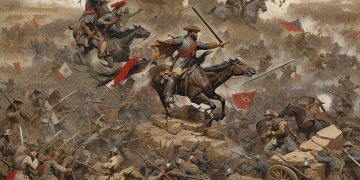The Battle of Stalingrad: Urban Warfare’s Decisive Impact

The Battle of Stalingrad marked a turning point in World War II’s Eastern Front, where brutal urban warfare transformed the conflict through intense close-quarters combat, devastating building-by-building struggles, and significant strategic implications, altering the course of the war.
The Battle of Stalingrad stands as one of the most brutal and pivotal conflicts in World War II. But how did **the Battle of Stalingrad: How Did Urban Warfare Impact the Eastern Front?** The answer lies in understanding the devastating consequences and tactical adaptations that arose from fighting within a destroyed city.
The Initial Onslaught and the City in Ruins
The initial German assault on Stalingrad transformed the city into a hellscape of rubble and twisted metal. The Luftwaffe’s relentless bombing raids reduced buildings to mere shells, creating a bizarre landscape that would heavily influence the subsequent fighting.
Before diving into the specifics of the fighting, it’s essential to understand the scope of the destruction and the geographical landscape that would become the battleground.
The Luftwaffe’s Devastating Impact
The German Luftwaffe played a crucial role in shaping the environment of Stalingrad. Their heavy bombing not only decimated the city’s infrastructure but also created a unique tactical domain.
- Strategic Bombing: The initial aim was to cripple Stalingrad’s industrial capacity and disrupt Soviet supply lines.
- Creation of Rubble: The aerial bombardment turned buildings into piles of debris, offering both cover and obstacles for advancing troops.
- Psychological Impact: The constant barrage demoralized the civilian population and the defending Soviet forces, complicating defense efforts.
Geographical Challenges and Opportunities
Stalingrad’s location on the Volga River and its urban sprawl presented unique challenges and opportunities for both sides, which significantly influenced military strategy.
- The Volga River: While essential for supply, it also segmented the city, making reinforcements and logistical support difficult.
- Urban Layout: The city’s industrial areas and residential districts provided numerous chokepoints and defensive positions.
- Elevated Positions: Key locations like Mamayev Kurgan became fiercely contested due to their strategic overview of the city.

The urban decay created by bombing raids presented obstacles for armored vehicles, funneling infantry into close-quarters combat. This initial phase set the stage for the months of brutal fighting that would epitomize the Battle of Stalingrad.
Close-Quarters Combat and Tactical Adaptations
As the battle progressed, the fighting devolved into intense close-quarters combat. This brutal, personalized form of warfare demanded new tactical approaches and skills.
The ruined buildings and narrow streets of Stalingrad forced soldiers to adapt to a style of fighting rarely seen on such a large scale.
The Rise of “Shturmoviki” Tactics
The Soviets developed specialized assault groups known as “Shturmoviki,” which were tailored for urban combat.
- Small Unit Tactics: These groups typically consisted of a handful of soldiers, including machine gunners, grenadiers, and flamethrower operators.
- House-to-House Fighting: They focused on clearing buildings room by room, using grenades and close-range weapons to overwhelm defenders.
- Coordination: Effective communication and coordination within the group were crucial for success.
German Adaptation and Challenges
The German forces, while initially successful in open terrain, struggled to adapt to the close-quarters combat in Stalingrad.
- Initial Disadvantages: German tactics were designed for combined arms operations in open areas, not urban settings.
- Adapting Strategies: They began to mimic Soviet tactics, forming their own assault groups and relying more on infantry.
- Logistical Issues: Supplying troops in the dense urban environment became increasingly difficult, straining resources.
These tactical adaptations transformed the battlefield into a deadly maze, where survival depended on quick thinking, adaptability, and sheer brutality.
The Human Cost: Atrocities and Survival
The Battle of Stalingrad was not only a military confrontation but also a human tragedy of immense proportions. The atrocities committed and the struggle for survival defined the experience for both soldiers and civilians involved.
The dehumanizing conditions of the siege tested the limits of human endurance, with both sides facing starvation, disease, and constant danger.
The Atrocities Committed
The intense fighting led to numerous atrocities committed by both sides, further escalating the horror of the battle.
- Brutal Reprisals: Both German and Soviet forces engaged in summary executions of suspected saboteurs and deserters.
- Targeting Civilians: Civilians were often caught in the crossfire and deliberately targeted in some instances.
- Lack of Medical Care: Wounded soldiers frequently died due to the lack of medical supplies and facilities.
Survival in Hell
For the civilians and soldiers trapped in Stalingrad, survival became a daily struggle against the elements and each other.
- Starvation: Food supplies were rapidly depleted, leading to widespread starvation and desperation.
- Disease: Overcrowding and poor sanitation contributed to the spread of diseases such as dysentery and typhus.
- Psychological Trauma: The constant shelling, gunfire, and death took a heavy toll on the mental health of everyone involved.

The human cost of the Battle of Stalingrad was staggering, leaving lasting scars on the survivors and serving as a grim reminder of the horrors of total war.
Strategic and Logistical Implications
The urbanized battleground of Stalingrad presented significant strategic and logistical challenges that greatly affected the outcome of the Eastern Front conflict.
Efficient resource management and adapting strategies were necessary for enduring the harsh conditions of the siege.
Logistical Nightmares
The urban landscape made logistical support a massive challenge for both armies, impacting their ability to sustain operations.
- Supply Line Disruptions: The narrow streets and relentless fighting often cut off supply lines, hindering the delivery of essential materials.
- Ammunition Shortages: The high intensity of combat led to rapid depletion of ammunition stocks, forcing soldiers to conserve resources.
- Reinforcement Difficulties: Moving reinforcements through the city was slow and perilous, exposing troops to constant danger.
Strategic Realignment
The battle forced both sides to reassess their strategic priorities and adapt their overall approach to the war on the Eastern Front.
- German Overextension: The focus on Stalingrad diverted resources from other critical areas, weakening the overall German offensive.
- Soviet Resilience: The successful defense of Stalingrad demonstrated the resilience of the Soviet forces and their ability to withstand immense pressure.
- Shifting Momentum: The battle marked a turning point in the war, shifting the momentum in favor of the Soviet Union.
The logistical and strategic challenges of Stalingrad reshaped the dynamics of the Eastern Front, playing a critical role in the eventual Soviet victory.
The Impact on Military Doctrine
The unique environment of Stalingrad significantly influenced military doctrine for both the Soviet and German armies, with lasting impacts on urban warfare strategies.
Insights from the battle changed how future combat operations were approached and conducted.
Soviet Adaptations
The Soviets learned valuable lessons about urban warfare, which they later applied in other battles.
- Specialized Training: They developed training programs focused on close-quarters combat and urban assault tactics.
- Engineering Support: Recognizing the importance of fortifications, they increased the use of engineering units to create defensive positions.
- Combined Arms Coordination: Improved coordination between infantry, artillery, and armored units enhanced their overall effectiveness in urban settings.
German Reassessments
The German army was forced to reevaluate its tactics and equipment based on the Stalingrad experience.
- Equipment Modification: They realized the need for more specialized equipment for urban warfare, such as close-range weapons and demolition tools.
- Tactical Restructuring: They revised their tactical doctrine to better account for the challenges of fighting in built-up areas.
- Emphasis on Infantry: The battle highlighted the importance of infantry in urban combat, leading to greater emphasis on infantry training and equipment.
These changes in military doctrine reflected the profound impact of the Battle of Stalingrad on the future of warfare, emphasizing the necessity of adaptability and specialization in urban environments.
Lasting Legacy and Commemoration
The Battle of Stalingrad holds a significant place in history, commemorated through various monuments, museums, and cultural representations.
These memorials serve as poignant reminders of the battle’s impact and its enduring legacy.
Monuments and Memorials
Numerous monuments and memorials have been erected in Stalingrad (now Volgograd) to honor the soldiers and civilians who perished in the battle.
- Mamayev Kurgan: This hilltop memorial complex features towering statues and monuments commemorating the fallen heroes.
- The Panorama Museum: This museum houses an impressive collection of artifacts and exhibits related to the battle, including a panoramic painting depicting the fighting.
- Eternal Flame: A symbolic flame burns continuously at the site of mass graves, honoring the memory of those who died.
Cultural Representations
The Battle of Stalingrad has been depicted in numerous books, films, and documentaries, highlighting its historical significance.
- Surgical Operations During the Great Patriotic War: A seminal book that captured the essence of the brutal combat conditions.
- Enemy at the Gates: A popular film that dramatizes the battle, bringing its intensity to a wider audience.
- Documentaries: Various documentaries explore the historical context, strategic importance, and human impact of the battle.
The lasting legacy of the Battle of Stalingrad serves as a testament to the resilience of the human spirit and the enduring lessons learned from one of the most pivotal conflicts in history.
| Key Aspects | Brief Description |
|---|---|
| 💣 Initial Bombing | The Luftwaffe’s bombing transformed Stalingrad into a landscape of rubble. |
| ⚔️ Close Combat | Fighters adapted to house-to-house combat, and small unit tactics. |
| 😥 Human Cost | Atrocities were rampant, and starvation and disease plagued both soldiers and civilians. |
| 🇷🇺Strategic Shift | The battle marked a shift in momentum, leading to eventual Soviet victory. |
Frequently Asked Questions
Stalingrad was a key industrial center on the Volga River, providing access to vital resources. Capturing it would cut off Soviet supply lines and provide access to the Caucasus oil fields, essential for the German war effort.
Urban warfare in Stalingrad involved navigating rubble-filled streets, fighting in ruined buildings, and dealing with disrupted supply lines. Close-quarters combat and constant danger posed significant tactical and logistical challenges.
The Soviets developed “Shturmoviki” assault groups specialized in house-to-house fighting. They improved coordination between different units and used engineering to create defensive positions in urban terrain.
The battle devastated the civilian population, leading to widespread starvation, disease, and death. Atrocities committed by both sides added to the suffering, making survival a daily struggle for those trapped in the city.
The Battle of Stalingrad is commemorated through monuments, museums, and cultural representations, including films, books, and documentaries. These memorials honor the sacrifices made and highlight the battle’s historical significance.
Conclusion
The Battle of Stalingrad indelibly altered the course of World War II. Urban warfare transformed the conflict by demanding brutal close-quarters tactics and innovative military doctrines. The battle serves as a testament to human resilience and stands as a solemn reminder of the devastating consequences of urban warfare.





